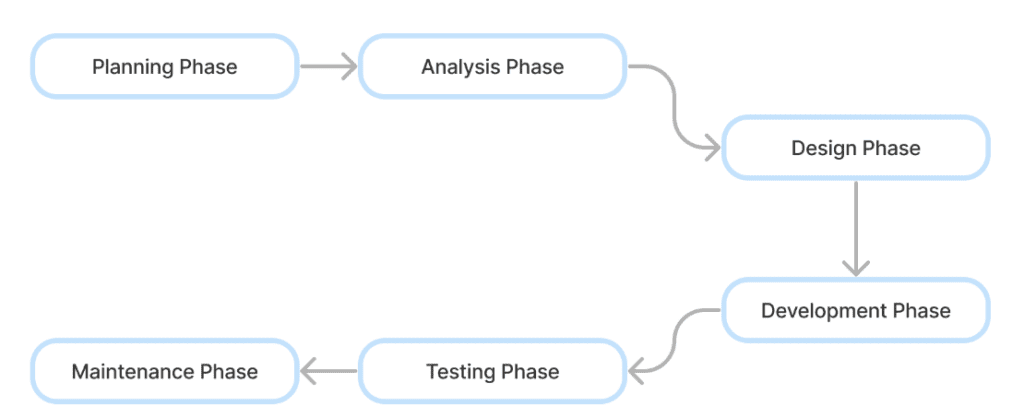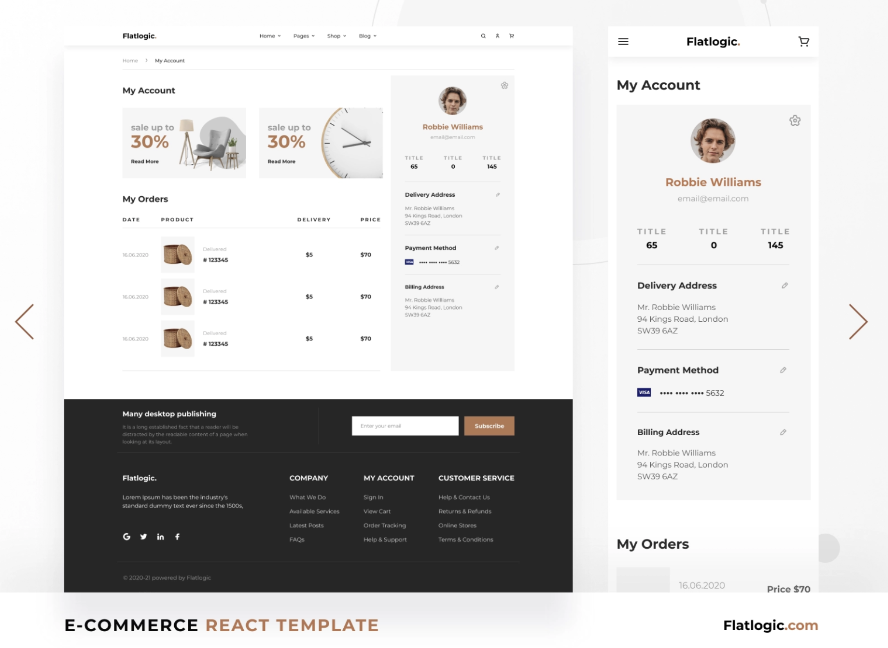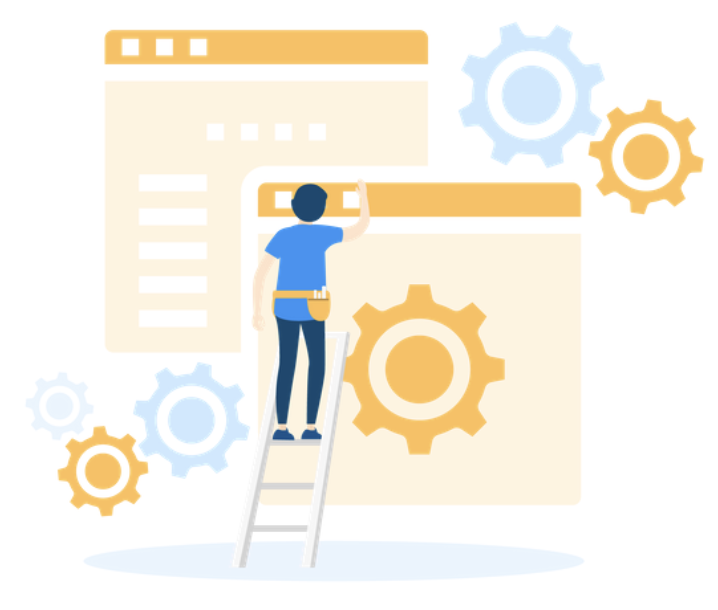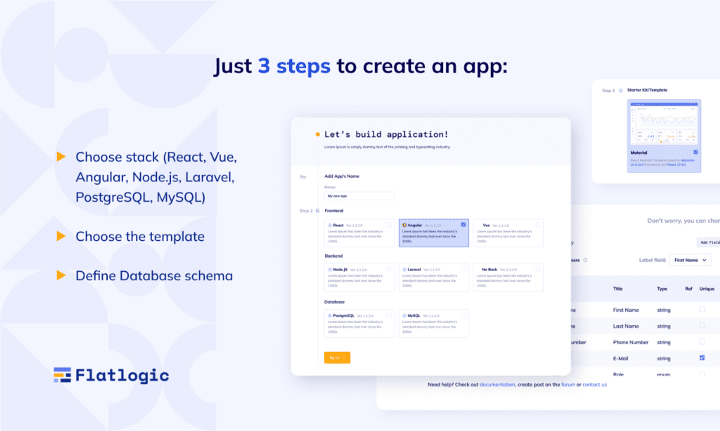TL;DR
- SDLC brings structure to software projects, avoiding delays and maintainability issues
- The six SDLC phases: planning, analysis, design, development, testing, maintenance
- Models covered: Waterfall, Agile, DevOps, Spiral, Prototype, Iterative; pick per risk and speed needs
- Benefits include clearer communication, risk control, quality assurance, and lower time/cost
- Flatlogic Platform claims 20%+ faster development via automation and analytics
Fact Box
- The SDLC here has six phases: planning, analysis, design, development, testing, and maintenance.
- SDLC models covered: Waterfall, Agile, DevOps, Spiral, Prototype, Iterative.
- The SDLC is iterative; teams revisit steps as requirements and technology change.
- Flatlogic says its Platform can speed up development by 20% or more. Source
- Planning sets scope, deadlines, budget; adds risk, communication, QA, and feedback plans.
When it comes to creating business software for an enterprise or some complicated CRM software, it can be difficult to know how to start. After all, there are many factors to consider, such as defining the problem correctly and ensuring that the software can effectively address it.
Creating software without planning is a recipe for disaster. Without proper planning, the software may be rushed, inefficient, and lacking the features needed. Furthermore, the software may be challenging to maintain and upgrade, as it was not designed with scalability or extensibility.

Creating software “as-is” vs. planning
Planning is an essential part of creating any software, as it allows the developers to understand the scope of the project, identify the best technologies to use, and create a timeline to ensure the project is completed on time. Just as with everything in life, having a plan is better than not having one.
One of many approaches that can be helpful in navigating this process is the Software Development Life Cycle (SDLC). This framework provides a structured approach to software development, guiding the process from conception to deployment. So how would you know where to begin it?
Then how would you ensure that you define the problem correctly so that your software can handle it correctly? Perhaps, on the other hand, what if you already get the software’s code base but don’t know what to do with it? These questions are the most powerful reason for the implementation of something like SDLC.
What is SDLC?
SDLC is a framework that outlines the steps necessary to create an effective and efficient software system. SDLC solutions can help organizations address various problems, including 
- Poorly planned projects that end up taking longer than expected or going over budget.
- Unorganized development processes lead to delays and unnecessary mistakes.
- Unclear communication between teams or departments results in misunderstandings and mistakes.
- Lack of visibility into project progress, leading to unplanned delays.
- Insufficient testing and quality assurance processes lead to poor quality outcomes.

The SDLC consists of six phases: planning, analyzing, design, development, testing, and maintenance.
SDLC Phases
Planning
The scope and objectives of the project are determined during the planning phase. It is the foundation stage that establishes the scope and objectives of the project. During this phase, the project team will define the project scope, set deadlines, and identify the resources needed to complete the project. The team will also create a project plan outlining the various tasks that need to be completed and the sequence in which they need to be completed. Risk management plans are also put in place during this phase to help identify potential risks that may arise. It is important to ensure that the project objectives are achievable and that the team has the skills and resources necessary to complete the project on time and within budget. The planning phase is vital to the success of the project and sets the tone for the rest of the SDLC.

The team should also create a project budget and timeline to ensure that the project is completed on time and within budget. The team should also create a quality assurance plan to ensure that the software meets the user requirements and is bug-free. Furthermore, the team should create a communication plan to ensure that all stakeholders are kept informed of the progress of the project. The team should also create a risk management plan to identify and mitigate any potential risks during the project. Finally, the team should create a user feedback system to ensure that any issues are identified and addressed quickly. This phase is important to ensure that the project is properly planned and managed to ensure its success.
Analysis
The SDLC Analysis Phase is the second part of the software development life cycle. In this phase, the project team will analyze the business requirements to understand what needs to be done to create the software solution. The team will document the user requirements, identify the system functions and features, and create a detailed design specification. The project team will also review the feasibility of the project and develop a timeline for completion. In addition, they will identify potential risks and create a risk management plan to mitigate them. The team will also create a cost analysis to determine the estimated cost of the project. This phase is key to the success of the project, as it provides the team with the necessary information to move forward with the project. It is important to ensure that the analysis phase is properly managed to ensure the project is successful.
The team will also consider various technologies that can be used to develop the software solution. They will analyze the strengths and weaknesses of the different technologies and determine which one is best suited to the project. The team will also analyze the market to identify any potential competitors and assess the current trends in the industry. Finally, the team will create a user interface design to ensure the software is user-friendly. During this phase, it is important to ensure that the team can identify areas of improvement and make the necessary changes to the design. By properly managing the analysis phase, the team will be able to create a successful software solution.
Design

The SDLC Design Phase is the third part of the software development life cycle. This phase is where the team begins to create the software. During this phase, the team will create the software architecture, design the user interface, and code the software. The team will also review the design and make any necessary changes. The design should include all of the user requirements, system functions, and features that were identified in the analysis phase. The team should also create a test plan to ensure that the software meets the user requirements and is bug-free. The design phase is critical to ensure that the software is user-friendly and meets all of the project requirements. It is important to ensure that the design is properly managed to ensure the success of the project.
Besides design, the team will also create a database that will store all of the data related to the software. The team will also create a data flow diagram that outlines the different processes that will take place within the software. The team will also create a system security plan to ensure that the software is secure from outside threats. Finally, the team will create a deployment plan to ensure that the software is properly deployed and maintained. This phase is important to ensure that the software is properly developed and the project is completed on time and within budget. It is important to ensure that the design phase is properly managed to ensure the success of the project.
Development

The SDLC Development Phase is the fourth part of the software development life cycle. During this phase, the team will create the software. The team will write the code and create the necessary files and components to complete the project. The team will also create a testing plan to ensure that the software is bug-free. During this phase, the project team should also create a version control system to ensure that the code is properly managed. This phase is key to the success of the project, as it ensures that the software is developed properly. It is important to ensure that the development phase is properly managed to ensure the success of the project.
The team should also select the appropriate software stack for the project. The software stack is the combination of programming languages, frameworks, and libraries that are used to build the software. It is important to select the appropriate stack to ensure that the software is properly developed and can meet the user’s requirements. The team should also consider the scalability of the stack to ensure that the software can grow and evolve as needed. This phase is important to ensure that the software is properly developed and the project is completed on time and within budget.
In addition to the development, the team will also create the necessary documentation for the software. This includes user manuals, installation guides, and system diagrams. The team should also create a training plan for users to ensure that they understand how to use the software. Furthermore, the team should create a bug-tracking system to ensure that any issues are identified and resolved quickly. Finally, the team should create an implementation plan to ensure that the software is properly deployed and maintained. This phase is important to ensure that the software is properly developed and the project is completed on time and within budget.
Actually, partnering with a custom software development company can provide a tailored SDLC approach, ensuring your project benefits from industry expertise, advanced technologies, and customized solutions that align with your specific business goals. This collaboration can significantly enhance the efficiency, scalability, and success of your software development projects.
Testing

The testing phase is used to verify the functionality of the system and ensure that it meets the specified requirements. During this phase, the team will test the software to ensure that it meets the user requirements and is bug-free. The team will create a test plan to identify the various tests that need to be completed and the sequence in which they should be completed. The team will also create a test environment to simulate the actual environment in which the software will be used. This phase is key to the success of the project, as it ensures that the software is tested thoroughly and meets all of the project requirements. It is important to ensure that the testing phase is properly managed to ensure the success of the project.
Apart from testing, the team will also perform security testing to ensure that the software is secure from outside threats. The team will also perform performance testing to ensure that the software can handle the expected load. The team should also create a documentation plan to ensure that all of the necessary documentation is created and maintained. Finally, the team should create a bug-tracking system to ensure that any issues are identified and resolved quickly. This phase is important to ensure that the software is properly tested and the project is completed on time and within budget.
Maintenance

Once the system is tested and verified, it is ready for the maintenance phase. During this phase, the team will monitor the software and make any necessary changes to ensure that it continues to meet the user requirements. The team will also create a maintenance plan to ensure that any changes or updates to the software are properly implemented. The team should also create a post-implementation review to evaluate the success of the project and identify areas of improvement. This phase is key to the success of the project, as it ensures that the software is maintained properly and can evolve as needed. It is important to ensure that the maintenance phase is properly managed to ensure the success of the project.
Besides maintenance, the team should also create a backup plan to ensure that the software and its data are protected in case of a disaster. The team should also monitor the performance of the software to ensure that it can handle the expected load. The team should also create a user feedback system to ensure that any issues are identified and addressed quickly. Finally, the team should create a change management system to ensure that any changes or updates to the software are properly documented and communicated to all stakeholders. This phase is important to ensure that the software is properly maintained and the project is successful.
SDLC Models
The SDLC Models are a set of methods used to create software applications. There are several different types of models, including the Waterfall Model, the Agile Model, the DevOps Model, the Spiral Model, the Prototype Model, and the Iterative Model.
- The Waterfall Model is a traditional method that follows a linear approach, with each phase of the SDLC being completed in sequential order.
- The Agile Model is a more modern approach that focuses on rapid development, short sprints, and frequent feedback.
- The DevOps Model is a hybrid of the Waterfall and Agile models that combines the best of both approaches.
- The Spiral Model is a risk-focused approach that allows for rapid iteration.
- The Prototype Model is an iterative approach that focuses on creating a prototype and testing it before proceeding with the development.
- Finally, the Iterative Model is an incremental approach that focuses on making small, incremental changes to the software.
Each model has its benefits and drawbacks, and it is important to choose the right model for the project. It is important to ensure that the project team is familiar with the selected model before beginning the project. This phase is important to ensure that the software is properly developed and the project is completed on time and within budget. The team should also consider the scalability of the model to ensure that the software can grow and evolve as needed. Furthermore, the team should create process documentation to ensure that the process is properly documented and can be followed by all members of the team. This documentation should include the steps of the model, the tools and techniques used, and any best practices that the team should follow. This documentation should be updated regularly to ensure that the process remains up-to-date and that the team is aware of any changes or updates.

Usage of SDLC
The SDLC is an iterative process, meaning that it is continually evolving and adapting to changes in the user’s requirements and technology. As new technologies and user needs emerge, the system must be modified to meet the new requirements. This requires that the SDLC be revisited and the steps outlined above repeated. By following the phases of the SDLC, software developers can create reliable and effective software systems that meet the user’s needs. The SDLC is an invaluable tool for any software developer and is essential for successful software development.
The Systems Development Life Cycle is used by software developers, software engineers, IT professionals, project managers, and business analysts. The SDLC is used to ensure that the system meets the user’s requirements and is built to last. It provides a framework for the successful development and maintenance of software systems and helps ensure that the system is built according to best practices and industry standards.
Benefits of Software Development Life Cycle
SDLC is a process used by information technology professionals to develop and maintain software systems. It is an essential process for the successful development and maintenance of software systems, and it offers numerous benefits.
- SDLC helps to ensure that the system meets the user’s requirements and is built to last. It provides a framework for the successful development and maintenance of software systems and helps ensure that the system is built according to best practices and industry standards.
- SDLC helps to facilitate better communication between the developers and the stakeholders. It helps to ensure that the stakeholders have a clear understanding of the system’s requirements and that the developers have a clear understanding of the stakeholders’ expectations.
- SDLC helps to identify potential risks associated with the project. By identifying and addressing potential risks early on, the project is more likely to be successful.
- SDLC helps to reduce the cost and time of software development. By following the steps of the SDLC, software developers can create reliable and effective software systems in a shorter amount of time and at a lower cost.
Why choose Flatlogic Platform as an SDLC solution?

Flatlogic Platform – is a platform that provides developers with the tools they need to quickly and efficiently build business software using the SDLC. Flatlogic Platform does offer the potential to speed up development by 20% or more compared to traditional manual software development processes. The platform’s automated tools, streamlined workflow, and comprehensive analytics all help to reduce the amount of time and effort required to complete projects. This can result in a notable improvement in development speed and efficiency.
Benefits of Choosing Flatlogic Platform
- Automated and streamlined workflow: Flatlogic Platform automates the software development lifecycle, from project planning to deployment. This streamlines the process and eliminates any manual steps, ensuring projects are completed on time and within budget.
- Easy-to-use interface: Flatlogic Platform has an intuitive, user-friendly interface that enables teams to quickly set up projects, create tasks, and manage timelines. This makes it easy for developers to stay organized and efficient throughout the project.
- Comprehensive analytics: The platform provides comprehensive analytics, allowing teams to track and analyze project progress and performance. This helps teams identify and address potential issues before they become problems, improving the overall quality of the end product.
- Secure and reliable: Flatlogic Platform is secure and reliable, ensuring data is stored safely and accessible only to authorized personnel. This helps protect sensitive customer information and ensures projects are completed efficiently.
Comments